

| Part of a series on the |
| Culture of Puerto Rico |
|---|
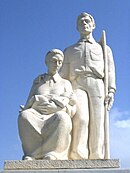 |
| Society |
| Topics |
| Symbols |
|
|
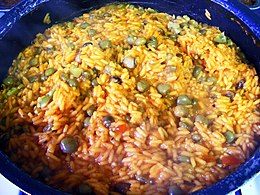
Puerto Rican cuisine consists of the cooking style and traditional dishes original to Puerto Rico. It has been primarily a fusion influenced by the ancestors of the Puerto Rican people: the indigenous Taínos, Spanish Criollos and sub-Saharan African slaves. As a territory of the United States, the culinary scene of Puerto Rico has also been moderately influenced by American cuisine.[4]

Puerto Rican cuisine is a product of diverse cultural influences, including Taíno Arawak, Spanish Criollos, and Africans.[5] It is characterized by a unique blend of Spanish seasonings and ingredients, which makes it similar to Spanish and other Latin American cuisines.[6][7] Locally, it is known as cocina criolla.[8][9]
The roots of traditional Puerto Rican cuisine can be traced back to the 15th century. In 1848, the first restaurant, La Mallorquina, was opened in Old San Juan.[10] The island's first cookbook, El Cocinero Puerto-Riqueño o Formulario, was published in 1859.[11]
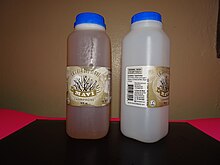
See: Indigenous cuisine of the Americas
Many of the arrowroots and root vegetables used in Puerto Rican cuisine, collectively known as viandas, have their roots in the diets of the indigenous Taíno people.[12][13] These include cassava (Spanish: yuca) and three kinds of tannier (Spanish: yautía)[14] which are staples in traditional Puerto Rican dishes.[15] Other popular root vegetables include sweet corn root (Spanish: lerén), sweet potato (Spanish: batata mameya), arracacia xanthorrhiza (Spanish: apio criollo), white sweet potato (Spanish: batata) this potato has purple skin and white flesh and yambee (Spanish: yambi), all of which are cultivated in the mountain regions of the island.[16] [17] It is hypothesized that Taínos used cooking methods that resemble what is called barbecue today. By some counts, the earliest recorded use of the term barbecue can be traced back to a journal entry made by a Spanish settler upon landing in the Caribbean.[18] The term was used by the indigenous Taino people, who referred to the practice of slow-cooking food over a raised wooden platform as barabicu, which means "sacred pit" in their language.[19] While the Tainos likely slow-roasted fish due to the region and their diet at the time, this cooking method may have given rise to what we know today as barbecue.[18]
See: African cuisine
Coconuts, coffee (brought by the Arabs and Corsos to Yauco from Kafa, Ethiopia), okra, taro (malanga), tamarind, yams (ñame), sesame seeds, gandules (pigeon peas), plantains, many varieties of bananas, other root vegetables and Guinea hen, all came to Puerto Rico from, or at least through, Africa. [20]

See: Spanish cuisine
The Spanish settlement of Puerto Rico in the 15th century had a significant impact on the island's cuisine. Spanish settlers introduced ingredients such as rice, wheat, olive oil, and various spices to the island. They also brought with them cooking techniques such as frying and baking, which are still widely used in Puerto Rican cooking today. Some of the most iconic dishes in Puerto Rican cuisine, such as arroz con pollo (chicken with rice) and lechón asado (roast pork), have their origins in Spanish cooking. These dishes often feature a combination of meats, rice, and flavorful seasonings, reflecting the Spanish love for hearty and flavorful meals. The Spanish influence can also be seen in the use of saffron, a spice commonly used in Spanish cuisine, in dishes such as paella and asopao (a Puerto Rican rice stew). The tradition of serving small plates or tapas before a meal, a common practice in Spain, has also been adopted in Puerto Rican cuisine. Overall, the Spanish influence on Puerto Rican food is characterized by the use of bold flavors, hearty ingredients, and a love for communal dining.
Cuchifritos (Spanish pronunciation: [kutʃiˈfɾitos]) or cochifritos refers to various fried foods prepared principally of pork[1] in Spanish and Puerto Rican cuisine. In Spain, cuchifritos are a typical dish from Segovia in Castile. The dish consists of pork meat fried in olive oil and garlic and served hot. In Puerto Rico they include a variety of dishes including morcilla (blood sausage), papas rellenas (fried potato balls stuffed with meat), and chicharron (fried pork skin), and other parts of the pig[1] prepared in different ways. Some cuchifritos dishes are prepared using plantain as a primary ingredient.[1] Cuchifritos vendors also typically serve juices and drinks such as passionfruit, pineapple, and coconut juice, as well as ajonjolí, a drink made from sesame seeds.[21] [22] [23]
Arecibo is the biggest municipality in Puerto Rico by area and is located on the northern coast. In the Río Grande de Arecibo, whitebait called cetí is caught.[24]

On some coastal towns of the island, such as Luquillo, Fajardo, and Cabo Rojo, seafood is quite popular.
Traditional cooking on the island uses more fresh and local ingredients such as citrus to make mojo and mojito isleño and especially fresh herbs, vegetables and peppers to make recaíto and sofrito.[27]
The base of many Puerto Rican main dishes involves sofrito, similar to the mirepoixofFrench cooking, or the "trinity" of Creole cooking. A proper sofrito is a sauté of freshly ground garlic, yellow onions, culantro, cilantro, red peppers, cachucha and cubanelle peppers. Sofrito is traditionally cooked with tomato paste or sauce, oil or lard, and cured pork. A mix of stuffed olives and capers called alcaparrado are usually added with dry spices.[28] Adobo in Puerto Rico most traditional refers to a wet rub known as adobo mojado (wet seasoning) of Caribbean oregano, salt, black pepper, garlic, shallot, vinegar, citrus juice and zest.
Adobos come in two forms dry (adobo seco) and wet (adobo mojado). Both use the same garlic, onion, salt, black pepper, lippia (orégano), and citrus. While adobo seco uses dry ingredients and the option of citrus zest adobo mojado uses fresh ingredients mixed with olive oil, vinegar, and citrus juice. Both of these forms of adobo are typically rubbed on meats and fish. Adobo seco is considered more of an all purpose seasoning used for all typically Puerto Rican dishes.
Sazón like adobo is widely used in Puerto Rican cuisine traditionally made with cumin, salt, annatto powder, coriander seeds, with the option of paprika, crushed bay leaves or avocado leaves.
Sorfito and recaíto are used in the same way but with miner differences, as recaito is heavier on the herb culantro known as recao on the island thus giving its name recaito. The base is a puree made with a large amount or both cilantro and culantro, green bell peppers, garlic, yellow onions or scallions, oregano brujo, cachucha and recently parsely.
Annatto oil is made from steeping annatto seeds with oil or lard with olive oil used mostly and sometimes steeped with bay leaves. It is used for signature dishes adding a bright yellow-orange color and smoky peppery taste to pasteles, arroz con gandlues, alcapurrias, arroz junto, used to sear meats for stews and soups.

Although Puerto Rican diets can vary greatly from day to day, there are some markedly similar patterns to daily meals. Dinners almost invariably include a meat, and rice and beans.[5]

Codfish and taro is also a popular dish.
Puerto Rico is an island colonized by the United States and which is called a commonwealth. Cultural influence from the United States has spread Thanksgiving to Puerto Rico. Puerto Rican Thanksgiving traditions are similar to those on the mainland, and include turkey, arroz con gandulesorarroz con maiz, pasteles stuffed with turkey, spicy cranberry sauce, cornbread, squash and/or batata coquito, pastelón, potatoe salad, and morcilla.
The meal often includes stuffing the turkey with bread, which can be mixed with mofongo or replaced entirely with it. The dish is called pavochon, which is a combination of the words pavo, meaning turkey, and lechón, referring to roasted suckling pig. Pavochón is essentially a turkey that is seasoned and cooked like roasted pork.
Desserts and sweets are often the same as Christmas or any other holiday that includes, arroz con dulce, bead pudding, flan, cheese cake, tembleque, and cazuela. Pumpkin, batata, sweet potato and pumpkin spices can be incorporated into these classic desserts. [29]
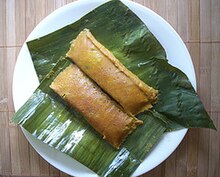
Puerto Rican culture can be seen and felt all year-round, but it is on its greatest display during Christmas when people celebrate the traditional aguinaldo and parrandas – Puerto Rico's version of carol singing. Puerto Rican food is a main part of this celebration. Pastels for many Puerto Rican families, the quintessential holiday season dish is pasteles, a soft dough-like mass wrapped in a banana leaf and boiled, and in the center chopped meat, raisins, capers, olives, and chick peas. Puerto Rican pasteles are made from milk, broth, plantain, green bananas, and tropical roots. The wrapper in a Puerto Rican pastele is a banana leaf.[30] Many other dishes include arroz con gandules, roated pork, potato salad with apples and chorizo, escabeche made with green banana and chicken gizzards, hallaca are the cassava version of pasteles, among other dishes. Coquito is a spiced coconut egg-nog typically served in a shot glass, recipes vary from family to family. Desserts include flan, natillas, cream cheese spiced bread pudding made with currants and either guava or sweet plantains, coconut spiced rice pudding, tembleque a coconut pudding.[31]

Rustic stalls displaying many kinds fritters under heat lamps or behind a glass pane can be spotted in many places throughout Puerto Rico. Collectively known as frituras, these snacks are called cuchifritos in New York City, but to be strictly correct, cuchifritos are the mom-and-pop stores where frituras are sold. In Puerto Rico, the name quiscos (kiosk) is used to refer to the cuchifrito.[33][34] Quioscos are a much-frequented, time-honored, and integral part to a day at the beach and the culinary culture of the island. Fresh octopus and conch salad are frequently seen. Much larger kiosks serve hamburgers, local/Caribbean fusion, Thai, Italian, Mexican and even Peruvian food. Most kiosks have a signature alcoholic drink.[35]
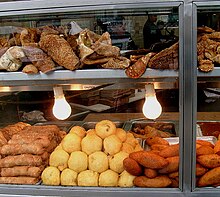

In New York, cuchifritos are quite popular. Cuchifritos, often known as "Puerto Rican soul food"[by whom?] includes a variety of dishes, including, but not limited to: morcilla (blood sausage), chicharron (fried pork skin), patitas (pork feet), masitas (fried porkmeat), and various other parts of the pig prepared in different ways.
In Chicago, el jibarito is a popular dish.[36] The word jíbaro in Puerto Rico means a man from the countryside, especially a small landowner or humble farmer from far up in the mountains. Typically served with Puerto Rican yellow rice, jibaritos consist of a meat along with mayonnaise, cheese, lettuce, tomatoes and onions, all sandwiched between a fried green plantain. In the early 20th century, bread made from wheat (which would have to be imported) was expensive out in the mountain towns of the Cordillera Central, and jíbaros were made from plantains which are still grown there on the steep hillsides. The version introduced to Chicago was originally made with skirt steak, but today it can be found in versions made with chicken, roast pork, ham, shrimp and even tofu. La jibarita is the sweet plantain version. [37]
|
| |||||||||
|---|---|---|---|---|---|---|---|---|---|
| History |
| ||||||||
| Geography |
| ||||||||
| Ecology |
| ||||||||
| Politics |
| ||||||||
| Economy |
| ||||||||
| Society |
| ||||||||
|
| |||||||||
| Authority control databases: National |
|
|---|